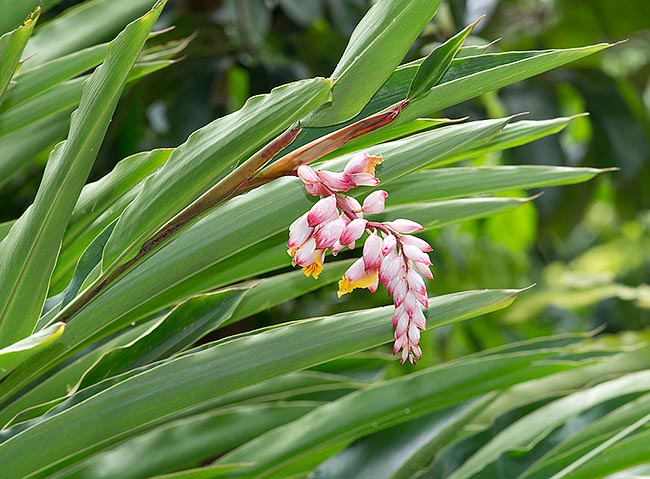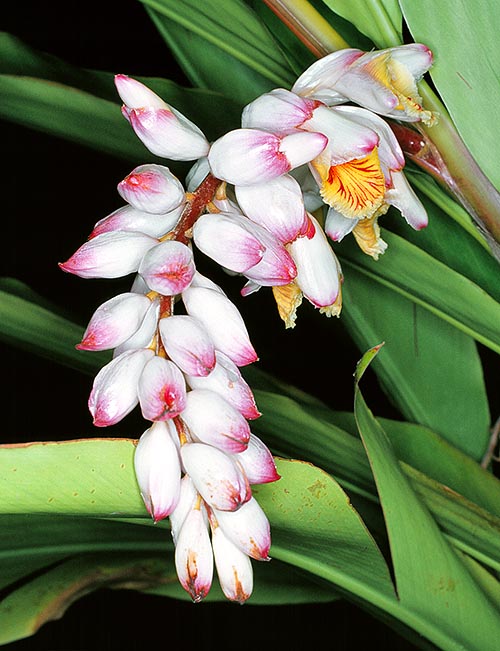Family : Zingiberaceae

Text © Pietro Puccio

English translation by Mario Beltramini

Alpinia zemburet is a south-east Asian perennial herbaceous species with 2-3,5 m stems © Giuseppe Mazza
The genus is honoured to the Italian physician and botanist Prospero Alpini (1553-1617); the specific name is the local one utilized in India.
Common names : light galangal, pink porcelain lily, shell-flower, shell ginger (English); punnag champa (Bengali); da cao kou, yan shan jiang (Chinese); langkawas na pula (Tagalog); gingembre coquille, fleur coquillage, larmes de la vierge, fleur du paradis (French); chatiun (Hindi); galoba merah, galoba koi (Indonesian); colônia, cuité-açu, gengibre-concha, louro-de-baiano, pacova (Portuguese-Brazil); boca de dragón, boca de lobo, cojate, collar de novia, dragón, lobo, pepu, perlas de oriente, raíz de paraíso (Spanish); Porzellan-Ingwer-lilie (German); khaa khom (Thai); gừng ấm, riềng ấm, riềng đẹp, sẹ nước (Vietnamese).
The Alpinia zerumbet (Pers.) B.L.Burtt & R.M.Sm. (1972) is an evergreen rhizomatous perennial herbaceous species with 2-3,5 m long pseudostems and alternate leaves, simple from lanceolate to oblong-lanceolate with pointed apex and margins provided of short down, 30-65 cm long and 5-12 cm broad, coriaceous, of bright green colour.
Drooping panicle terminal inflorescences, 25-40 cm long, waxy flowers with white campanulate calyx with pink apex, 2-2,5 cm long, deeply etched along one side, white trilobed corolla with oblong lobes, the dorsal one 3,5 cm long and 3 cm broad, the lateral ones 3 cm long and 2 cm broad, ovate labellum with rippled margin, 4-6 cm long and 4 cm broad, yellow streaked with purple red, 2,5 cm long stamen and 4 cm long style.

Elegant 25-40 cm inflorescences. Easy cultivation and medicinal virtues © G. Mazza
Vigorous species that quickly heads cultivated for the luxuriant foliage and the ornamental inflorescences in the tropical, subtropical and warm temperate climate regions; temperatures around the -3 °C can destroy the aerial part whilst the rhizome can resist, well mulched, up to about -6 °C, for not too long periods, resuming to vegetate in spring, but in such case it does not bloom seen that the inflorescences are produced by the two years old stems.
It requires full sun or slight shade and is not particular about the soil, but grows better in draining soils rich of organic substance, acidic to slightly alkaline, with good water availability; useful are the fertilizations with balanced products with microelements.
Utilized for ornamental purposes, even for the foliage only, in the gardens and in pot, for the decoration of inner spaces, the variegated yellow and green variety, of size more contained than the species, and the ‘Variegata Dwarf’, only 30 cm tall.
The aromatic leaves are utilized for wrapping the rice or the fish while cooking, the rhizome is used as surrogate of the ginger, the apex of the young stems, the leaves and the flowers are locally consumed boiled. The stems, formed for the 50% by cellulose are employed in the paper making.
Parts of the plant are variously utilized in the popular medicine, not only in the origin areas, but also in those where it has been introduced and has naturalized since time, such as Brazil and the Caribbean, mainly as diuretic, antihypertensive, antiulcerogenic, antioxidant and sedative; its active principles are object of numerous researches for the possible use in the official pharmacopoeia.
Finally, the leaves, especially the variegated ones, are often utilized in the floral compositions.
Synonyms: Zerumbet speciosum J.C.Wendl. (1801); Renealmia nutans Andrews (1804); Costus zerumbet Pers. (1805); Amomum nutans (Andrews) Schult. (1822); Alpinia cristata Griff. (1861); Alpinia speciosa (J.C.Wendl.) K.Schum. (1889); Alpinia nutans var. longiramosa Gagnep. (1902); Alpinia fimbriata Gagnep. (1904); Alpinia schumanniana Valeton (1904); Languas speciosa (J.C.Wendl.) Small (1913); Alpinia fluvitialis Hayata (1915); Languas schumanniana (Valeton) Sasaki (1924); Renealmia spectabilis Rusby (1927); Catimbium speciosum (J.C.Wendl.) Holttum (1950).
